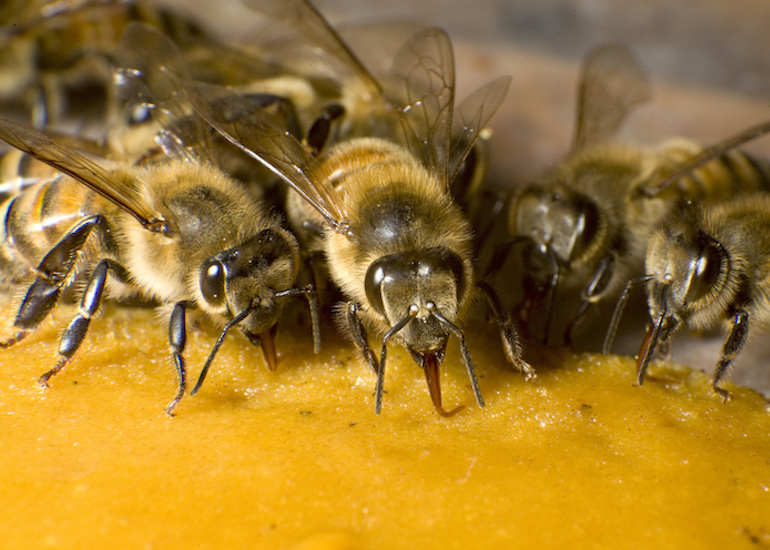 by Véto-pharma
by Véto-pharma Winter represents the most physiologically demanding stage in the annual cycle of honeybee colonies. With brood rearing halted and foraging impossible, survival depends entirely on internal resources and energy efficiency. The colony must sustain a stable temperature core of around 35°C despite outdoor conditions, relying solely on stored honey and the metabolic heat produced by the cluster.
Three key pillars ensure overwintering success: energy reserves, space allocation, and sanitary health. These interdependent factors directly determine whether a colony can conserve sufficient energy to remain viable until next spring. Optimizing this triad has therefore become a cornerstone of modern beekeeping management strategies aimed at reducing winter losses (Döke et al., 2015; Gray et al., 2024)1-2.
The winter cluster constitutes the anatomical and functional unit for thermoregulation in a honey bee colony. Worker bees form a dense sphere that contracts and expands depending on ambient temperature, concentrating heat in the brood area or central core. Metabolic heat results from the oxidation of honey-derived carbohydrates, primarily through vigorous muscle contractions of the thoracic flight muscles, a process that consumes significant energy reserves (Jones et al., 2007)3.
Colony size and the physiological condition of the workers are critical. Colonies overwintering in Dadant hives generally maintain an adult bee population between 15,000 and 20,000 individuals at the onset of winter. This population size ensures sufficient cluster thermal mass for effective heat retention, which is vital for winter survival in temperate regions. Studies confirm that colony survival rates increase substantially when winter populations remain above this threshold, while smaller clusters are more susceptible to cold stress and starvation (DeGrandi-Hoffman et al., 2025; van Dooremalen et al., 2012; Rajagopalan et al., 2024)4-6 and need more care to get through this period (feeding and monitoring).
Fat bodies play a dual role as energy stores and immune regulators; their depletion correlates strongly with overwintering failures (Döke et al., 2015; Brodschneider & Crailsheim, 2010)1, 7. The better the condition of winter bees, the greater the colony’s winter resilience.

During late summer and early autumn, environmental nectar and pollen become scarce, and honey bee colonies begin preparing for winter. Drones, which no longer contribute to the colony, are expelled as a way to reduce unnecessary energy consumption. At the same time, the winter cluster contracts, and the number of adult bees declines as long-lived winter bees replace the short-lived summer generation.
For a standard Dadant hive, beekeepers are advised to ensure a minimum of 15 to 20 kg of honey stores are available for winter, corresponding to three to four frames fully capped on both sides (4–5 kg per frame). This recommendation is supported by scientific studies from temperate zones; in northern regions or especially harsh winters, greater reserves may be required (DeGrandi-Hoffman et al., 2025; Jones et al., 2007).3-4
Reserve consumption during winter is significantly influenced by fluctuating temperatures, which force the cluster to repeatedly break and reform, thus increasing energy demand (DeGrandi-Hoffman et al., 2025)3. The beekeeper’s task is twofold: First, optimize hive tightness and space efficiency to reduce heat loss by removing empty combs and managing the cluster’s position. Second, verify that adequate reserves are present, supplementing with feeding (thick sugar syrup in autumn, fondant or candy in winter) as necessary. This approach ensures the cluster can access stores easily when mobility is restricted by cold.
Pollen and protein substitutes may be provided especially if autumn floral resources are insufficient, as these support the antioxidant system and enhance winter bee longevity (Brodschneider & Crailsheim, 2010; García-Vicente et al., 2024)7,8 . Monitoring reserves through regular hefting or hive scales helps beekeepers respond before starvation is imminent, safeguarding the colony’s energy continuity (APHA, 2021).9

Spatial management for a Dadant hive should begin right after the last harvest. It is essential to remove all honey supers—after allowing bees to clean up remaining stores—so as not to leave unnecessary volumes to heat. The process includes preparing follower boards or partitions, gradually tightening colonies from an average of eight frames down to an ideal of five or six occupied frames, compacting the bees and limiting the air space they must thermoregulate. This consolidation should be progressive and attentive to the colony’s strength, always ensuring that defective woodwork or poor insulation is corrected to prevent heat loss (DeGrandi-Hoffman et al., 2025)4
Efficient use of the available space not only preserves energy but also facilitates access to stores. Honey frames must be positioned directly adjoining the cluster, enabling a quick access for consumption during winter. Empty combs should be removed to prevent the cluster from spreading out and losing thermal cohesion. Further, reducing the hive entrance after harvest limits the threat of predators and rodents during colder months, and helps preserve internal warmth. Simultaneously, tight-fitting blocks and solid outer walls are critical to prevent draughts or excessive heat loss (Betterbee, 2023)10.
Maintaining the optimal balance between warmth and humidity is crucial for wintering honey bee colonies. While solid insulation conserves heat within the hive, proper ventilation—such as screened bottom boards that can be closed if necessary—prevents excessive moisture buildup, which can lead to chilling and disease. Effective air circulation minimizes condensation by allowing humid air to escape without excessive heat loss. This controlled ventilation ensures that the colony remains dry and warm, promoting its health throughout the winter (Brodschneider & Crailsheim, 2010).7
The success of overwintering depends as much on colony health as on nutrition or space. Varroa destructor control before the emergence of winter bees is critical, since parasitized bees exhibit depleted fat bodies and shortened lifespans. Autumn treatments must coincide with the rearing of these long-lived individuals to ensure their physiological resilience.
Integrated Pest Management (IPM) approaches—combining mechanical, chemical, and biotechnical tools—remain the cornerstone of sustainable winter preparation (Gray et al., 2024, Jack CJ, Ellis JD., 2021).2, 11 Well-timed miticide applications, brood interruption, and genetic selection for hygienic traits directly contribute to reduced overwintering mortality.
Honeybee winter survival is a multi-factorial process governed by the synergy between nutrition, hive structure, and health. Optimal energy management results not from any single intervention but from an integrated understanding of how reserves, space, and sanitary conditions interact. Proactive monitoring, informed feeding strategies, and disciplined pest management substantially improve resilience against winter stressors.
Sustaining these three pillars not only ensures energy conservation but also strengthens colony vitality for the following season—turning winter from a survival challenge into a foundation for spring renewal.
References:
 by Juan Molina
by Juan Molina  by Véto-pharma
by Véto-pharma